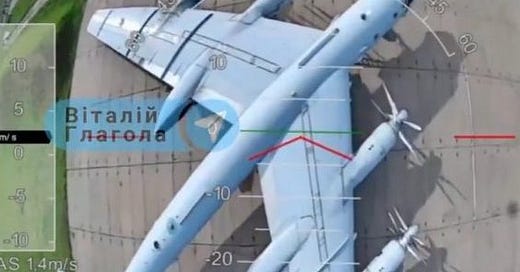Ukrainian Drones Just Took Out 1/3 of Russia's Bomber Force
The tiny drones launched from modified long-haul trucks parked near Russian bases
Ukraine’s security agency, the SBU, just pulled off a daring daylight operation targeting bomber bases across Russia.
Apparently hijacking Russian tractor-trailer trucks and loading them with specially-prepared containers housing short-range first-person-view attack drones, the SBU attacked Olenya and Belaya air bases—respectively 1,200 and 2,700 miles from Ukraine—with more than 100 drones and destroyed or damaged potentially scores of Russian warplanes, including Tupolev Tu-95 bombers, Beriev A-50 radar planes and transports.
The SBU claimed it hit more than 40 planes. The agency circulated videos, relayed across the Russian telecommunications network by the explosives-laden quadcopter drones, of four Tu-95s burning at Olenya.
The Russian air force operates 118 bombers including 15 Tupolev Tu-160s, 47 Tu-95s and 56 Tupolev Tu-22Ms. If the SBU’s claim is accurate, Ukraine may have eliminated a third of the force. Only the Tu-160 is still in production, albeit slowly and on a small scale.
“The blow to strategic aviation is not only a hit to Russia’s nuclear triad, but also a major setback to its power projection and geopolitical decision-making,” Ukrainian analysis group Frontelligence Insight observed. “With no easy or quick way to restore the loss, Russia may be forced to reassess the war’s cost-benefit ratio.”
The SBU was quick to explain how it executed the daring operation, even releasing photos of the drone containers in production.
There’s a reason for the transparency. “If you’re wondering why the SBU are being so open about the methodology behind today’s attack, imagine the impending disruption to Russian logistics as the [Russian security service] are forced to double-check a few million cargo containers for Ukrainian surprises,” explained Jimmy Rushton, a Kyiv-based security analyst.
The Russians should have seen the attack coming. Attacks by Ukraine’s long-range attack drones, as opposed to short-range quadcopters, have destroyed or damaged an A-50 and two Tu-22Ms while they were parked at their bases. The Ukrainians have also shot down two A-50s and at least one Tu-22M. Two other Tu-22Ms have crashed since Russia widened its war on Ukraine in February 2022.
The A-50s in particular are an endangered species. The Russian air force had just nine flyable A-50s on the eve of the wider war, and may have just five now.
“I don’t know who needs to hear this,” aviation expert Bill Sweetman quipped, “but it is probably a bad idea to line all your bombers up in a tidy row in the same place you have parked them for the last 30 years.”
Russia’s bombers routinely lob cruise missiles at Ukrainian cities, destroying entire apartment buildings and randomly killing civilians. Back-to-back drone and missile raids on Kyiv and other cities on May 24 and 25 involved hundreds of munitions.
Short of long-range air-defenses such as Patriot and SAMP/T batteries—the Ukrainian air force has six of the former and two of the latter, although more are on the way—Ukrainian forces increasingly target the Russian bombers, and their missile stocks, while they’re on the ground.
On the morning of March 20, Ukrainian drones targeted the Russian air force bomber base at Engels for the third time in 10 weeks. According to the Ukrainian general staff, the resulting blast destroyed 96 Kh-101 cruise missiles. Each Kh-101 costs $10 million, and Russian industry produces them at a rate of just a few dozen a month.
As air bases burned across Russia on Sunday, the surviving bombers took off to escape further attack. It could be a few days before we know for sure how many planes the SBU took out.
Air force leaders all over the world are surely watching … and worrying. “I wonder how many air forces will learn from today’s events that hardened aircraft shelters or at least proper close hangars are well worth the cost for parking your extremely expensive—and hard [or] impossible to replace—military aircraft,” mused analyst Jakub Janowsky.
The Russian reaction should be even more interesting.
Read more:
Russia's Dan-M Training Drone Mimics the U.S. Tomahawk Missile. Now It's Attacking Ukraine.
Russia fires Kh-101 cruise missiles at Ukraine practically as fast as it builds them. Reaching deep into their arsenal for alternatives to the multi-million-dollar missiles, the Russians found a handy alternative to the Kh-101: an target drone called the Dan-M.






2/3 to go…
Meanwhile Zelensky pockets another $100M and buys another home in West Palm Beach...